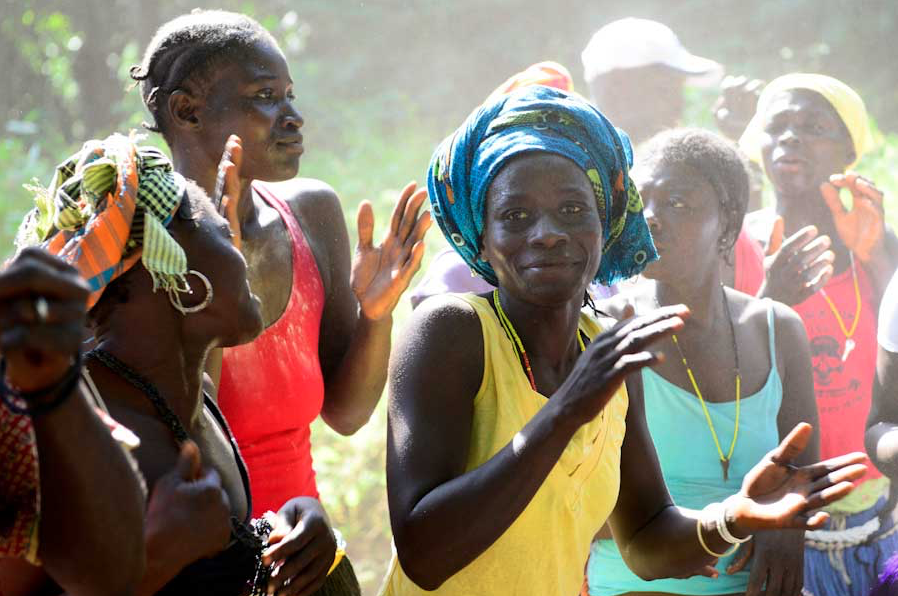
These women are living on the Orango Grande island in the Bijagos archipelago in Guinéa Bisseau - the same island as the Swedish film director Leyla Assaf Tengroth visited in the 70´s and then some decades later to make two documentaries about; Our God is a Woman and The Woman´s Island
Thereafter the Spanish anthropologist Anna Boyé visited the island to live in the jungle together with the married couple Quinta and Estevo and from her experiences she has got quite another story to tell, not at least regarding the women´s treatment of the men and the way men and women relate to one another, than what is communicated by the documentaries by Leyla Assaf Tengroth and the Swedish artist and opinionator Marianne Lindberg de Geer who since long has invested a great deal of energy in delivering her message about what she believes would be the abhorrent consequences of women wielding power, with these matriarchal women on the island Orango Grande as deterrent examples thereof.
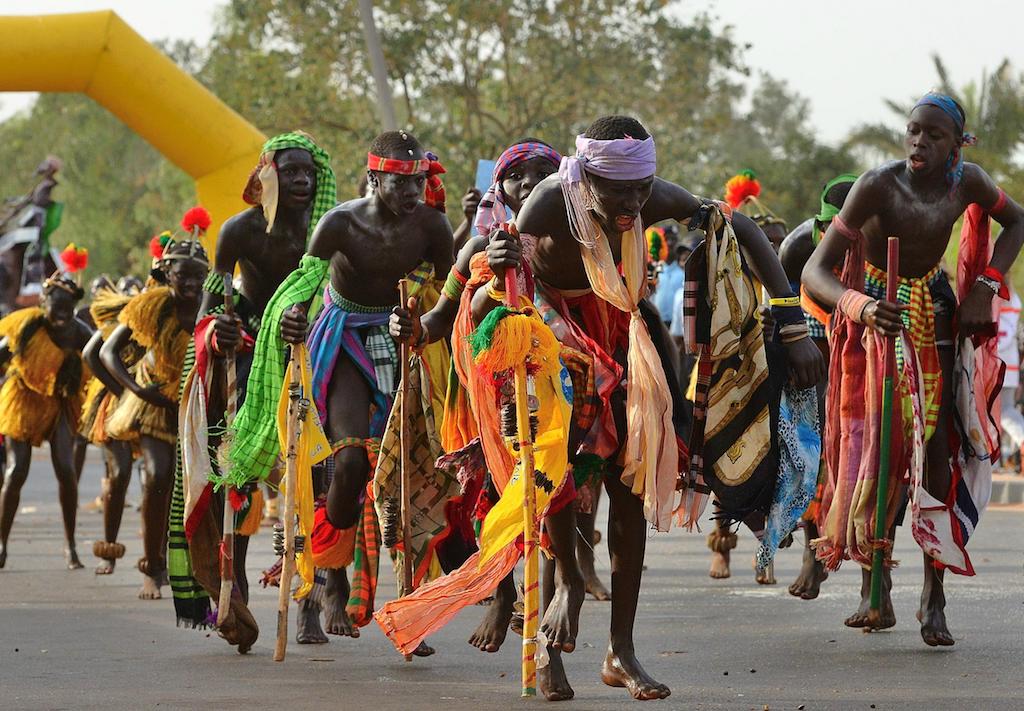
BIJAGOS´SOCIETY BEING MATRIARCHAL OR PATRIARCHAL -
THAT´S THE QUESTION!
As Heide Göttner-Abendroth´s states in her extensive tutorial work Matriarchal Societies, studies on Indigenous Cultures Around the Globe, (page xxv) 2012, never before there has been developed a systematically derived definition of "matriarchy" in established science, which has caused a lot of confusion, which not at least becomes evident when you start investigating what has been recorded about the Bijagos´ society online. Although som of the data in the history of the island Orango Grande delivered by one of the anthropologists who have been in charge on the Bijago archipelago; the Italian anthropologist Luigi Scantamburli might render some support to the picture of a society totally out of balance between men and women in the first half of the 20th century represented by Leyla Tengroth in her documentaries Our God is a Woman and The Woman´s Islands, most of the other reports from the inhabitants themselvers contradict this 180 degrees.
I will return to this further down.
The question is how trustworthy a man like Scantamburlo might considered to be, who in spite of an overwhelming amount of evidence all around him of the opposite, claims the Bijagos people´s societies to be patriarchal.
As there is not much written about the Westafrican societies in Göttner Abendroth´s work except for the Akan and Ashanti-people, I have now got a chance to test my knowledge and methodological skills by practising Göttner Abendroths metodological approach using her elaborate analytical tool in a private little investigation about these Bijago´s peoples being matriarchal or patriarchal.
My method will then be to compare different written records of the Bijagos society, analyse them according to Göttner Abendroths´s basic and deep structure definitions, and see what will come out of it; without claiming my investigation being professional done.
My own thesis in this specific topic, is that Tengroth´s / Lindberg de Geer´s passionate ambition to protect the supposed surpressed Bijagos men, suffering from being "work slaves" to their Bijagos women and to save them into modernity, is very contraproductive and harmful to these kind of indigenous cultures and doesn´t represent reality but more of their own preconceptions about so called "primitive people" and notably matriarchal such.
This is a well documented problem commented by many indigenous professional scholars as for example Ifi Amadiume, Helene Norberg Hodge. as well as trhe spanich anthropologist
Thus we have to start with the first short definitions elutriated by Göttner-Abendroth through inductive method:
"Matriarchy Presents us a well Balanced, Egalitarian and Peaceful Society without Wars and the Rule of Dominance"
Quote:
Agueda Gomez
Anna Boyé: Bijagó Society is very peaceful and no one remembers any crime of violence or blood done earlier.
Lorenzo Ibrahim Bordonaro:
Brandon D. Lundy:
Luigi Scantamburlo:
Quoting Dr Heide Göttner-Abendroth »
at the Homepage of
S H O R T D E F I N I T I O N
"Matriarchies are not just a reversal of patriarchy, with women ruling over men – as the usual misinterpretation would have it.
Matriarchies are mother-centered societies, they are based on maternal values: care-taking, nurturing, motherliness, which holds for everybody: for mothers and those who are not mothers, for women and men alike.
Matriarchal societies are consciously built upon these maternal values and motherly work, and this is why they are much more realistic than patriarchies. They are, on principle, need-oriented. Their precepts aim to meet everyone’s needs with the greatest benefit. So, in matriarchies, mothering – which originates as a biological fact – is transformed into a cultural model.
This model is much more appropriate to the human condition than the way patriarchies conceptualise motherhood and use it to make women, and especially mothers, into slaves."
Agueda:
BoyéBijagó: Society is very peaceful and no one remembers any crime of violence or blood done earlier.
Bordonaro:
Scantamburlo:
Lundy:
T H E D E E P S T R U C T U R E
of “matriarchal society” (a structural definition):
"With matriarchal cultures, equality means more than just a levelling of differences. Natural differences between the genders and the generations are respected and honoured, but they never serve to create hierarchies, as is common in patriarchy.
The different genders and generations have their own dignity, and through complementary areas of activity, they function in concert one other. More precisely, matriarchies are societies with complementary equality, where great care is taken to provide a balance. This applies to
the balance between genders, among generations and between humans and nsature.
Maternal values as ethical principles pervade all areas of a matriarchal society. It creates an attitude of care-taking, nurturing, and peacemaking.
This can be observed on all levels of society on the economic level, the social level, the politival level and the areas of their worldview and faiths
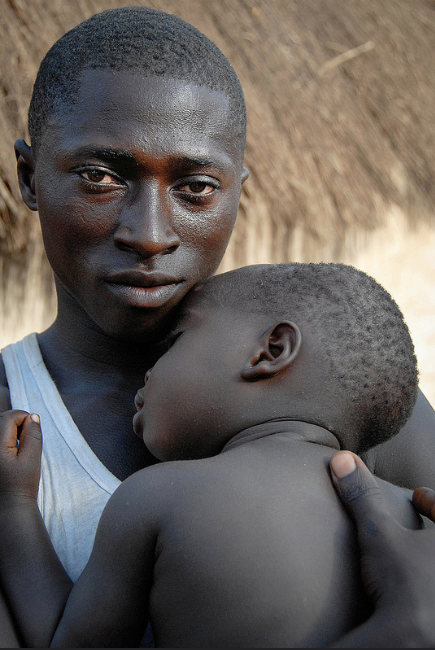
DEFINITION OF A "MATRIARCHAL SOCIETY"
At the economic level, matriarchies are most often agricultural societies, but not exclusively so. Goods are distributed according to a system that is identical with the lines of kinship and the patterns of marriage. This system prevents goods from being accumulated by one special person or one special group. Thus, the principles of equality are consciously kept up, and the society is egalitarian and non-accumulating.
______________________________________________________________________________________________________
The economy on the Bijagos islands is still selfsusta and built upon cultivating rise and some other vegatables, fishing anfd gathering; especially oisters in the mangove, as well as breeding of cows, pigs and goats as well as the giftgiviong economcal principle in wich .
The Bijagós is an archipelago of 88 tropical islands – the largest archipelago in Africa – off the coast of Guinea Bissau. Around only twenty of them are inhabited and the whole region has been a UNESCO Biosphere Reserve since 1996. The people of the islands are quite distinct from the mainland population, mainly thanks to the distance and time it takes to reach by boat. As a consequence, many of the islands have developed in isolation and traditions have remained intact.
Most of the inhabitants of the Bijagós islands subsist with incomes from farming and fishing. The boats are often simple wooden structures and, without access to new technologies, the fishermen navigate by the sun (or stars).
Orango is the largest of the Bijagós islands and contains a huge diversity of ecosystems, including savannah grassland and swamps. This tree, literally dripping with weaver bird nests, is on the shores of leech-infested swamp water. The birds create elaborate, pouch-like nests from leaf fibres, twigs and grass and happily live alongside much larger birds like egrets as well as the crocodiles and hippos in the waters below.
_____________________________________________________________________________________________________________
From a political point of view, matriarchies are societies with perfect mutuality. Every advantage or disadvantage concerning the acquisition of goods is mediated by social rules. For example, at the village festivals, wealthy clans are obliged to invite all inhabitants. They organize the banquet, at which they distribute their wealth to gain honor. Therefore, on the economic level they produce a balanced economy, and so I call matriarchies societies of economic reciprocity.
A population living in the region makes decisions in the same way: delegates from all villages meet to discuss the decisions of their communities. Again, the delegates function only as bearers of communication. In such cases, it is usually men who are elected by their villages. In contrast to the frequent ethnological mistakes made about these men, they are not the "chiefs" and do not, in fact, decide.
Every village, and in every village every clan-house, is involved in the process of making the decision, until consensus is reached on the regional level.
Therefore, from the political point of view, I call matriarchies egalitarian societies of consensus.
These political patterns do not allow the accumulation of political power. In exactly this sense, they are free from domination: They have no class of rulers and no class of suppressed people; that is, the enforcement bodies that are necessary to establish domination are unknown to them.
______________________________________________________________________________________________
According to the Italian anthroplogist Luigi Scarambo, as well as the Spanish anthropologists Anna Boyé and Gomez
_______________________________________________________________________________________________
At the social level, matriarchies are based on a union of the extended clan. The people live together in big clans, which are formed according to the principle of matrilineality; that is, kinship is acknowledged exclusively in the female line. The clan's name, and all social positions and political titles, are passed on through the mother's line. Such a matri-clan consists at least of three generations of women: the clan-mother, her daughters, her granddaughters, and the directly related men: the brothers of the mother, and her sons and grandsons. Generally, the matri-clan lives in one big clan-house, which holds anywhere from 10 to more than 100 persons, depending on size and architectural style. The women live there permanently, because daughters and granddaughters never leave the clan-house of their mother when they marry. This is called matrilocality.
What is most important is the fact that women have the power of disposition over the goods of the clan, especially the power to control the sources of nourishment: fields and food. This characteristic feature, besides matrilinearity and matrilocality, grants women such a strong position that these societies are "matriarchal." (Anthropologists do not make a distinction between merely matrilineal, and clearly matriarchal societies. This continues to produce great confusion.)
The clans are connected to each other by the patterns of marriage, especially the system of mutual marriage between two clans. Mutual marriage between two clans is not marriage between individuals, but rather a communal marriage. The married people do not leave the houses of their mothers, but practice visiting marriage. Due to additional patterns of marriage between all clans, everyone in a matriarchal village or a matriarchal town is eventually related to everyone else by birth or by marriage.
Therefore, I call matriarchies non-hierarchical, horizontal societies of matrilineal kinship.
Even the process of making a political decision is organized along the lines of matriarchal kinship.
In the clan-house, women and men meet in a council where domestic matters are discussed. No member of the household is excluded. After thorough discussion, each decision is taken by consensus. The same is true for the entire village: if matters concerning the whole village have to be discussed, delegates from every clan-house meet in the village council. These delegates can be the oldest women of the clans (the matriarchs), or the brothers and sons they have chosen to represent the clan. No decision concerning the whole village may be taken without the consensus of all clan-houses. This means that the delegates who are discussing the matter are not the ones who make the decision. It is not in this council that the policy of the village is made, because the delegates function only as bearers of communication. If the council notices that some clan-houses are of a different opinion, the delegates return to the clan-houses to discuss matters further. In this way, consensus is reached in the whole village, step by step.
____________________________________________________
__________________________________________________________________________________________________
On the cultural level, matriarchal societies do not have the concept of religious transcendence in terms of an unseen, untouchable, and incomprehensible all-powerful God, in contrast to whom the world is devalued as dead matter. In matriarchy, divinity is immanent, for the whole world is regarded as divine. This is evident in the concept of the universe as a goddess who created everything, and of Mother Earth, who brings forth everything living. And everything is endowed with divinity – the smallest pebble and the biggest star, each woman and man, each blade of grass and each mountain.
In such a culture, everything is spiritual. In their festivals, following the rhythms of the seasons, everything is celebrated: nature in its manifold expressions, the different clans with their different abilities and tasks, the different genders and the different generations, following the principle of "wealth in diversity." There is no separation between sacred and secular; so everyday tasks such as planting and harvesting, cooking and weaving are, at the same time, meaningful rituals.
On the spiritual level, I define matriarchies as sacred societies and cultures of the Goddess.
___________________________________________________________________________________________________
"Matriarchy Presents us a well Balanced, Egalitarian and Peaceful Society without Wars and the Rule of Dominance"
To this could be said that all reports agree about the Bijagos being well balanced societies regarding their environment being classifies as
Neither there seem to have been wars among the different Bijagos inhabitants themeselves or with he people living on the mainland.
At the other hand they seem to have been more prone to and capable of defending themselves against colonial rule by the Germans and Portugeese than many others, as the successfully resisted their takeover up until some decades in the beginning of the 19th century
But when it comes to the questions about these societies being egalitarian and nonhierarchical with neither sex dominating the other the opinion varies the more. But to the well informed MMS-trainee that´s nothing to get confused about as that´s the normal proceedure among the established male stream scholars; All societies are assessed as hierarchical and dominated by men whatsoever. And there is nothing they ever agreed so much about, as the fact that there never ever has been a matriarchy (although not even knowing what is meant thereby - as they never cared to work out a scientifically aprovable definition thereof)
By a quick glance at a traditional Bijago village, as you for example might have in some of the videos at youtube, (linkede to further down) and its inhabitants you immidierately get the impression of its being a typical traditional African village with no exterior signs of a hierarchical class society with great differences between rich and poor or a male dominated one with inferior and subdued women, as for example in many arabic countries, where they have to veil themselves or hide brehind closed doors. Quite the contrary everyone, both men and women as well as the children seem to be jaunty and undaunted, signalling a proud self esteem and joyful attitude, treating the tourists with benignant but definitively not any kind of subduing dignity.
Another thing that´s notable among the established scholars is the unlogical carriage prevailing close under surface of certitude, that strongly contravene their fix idea about the non-existence of matriarchy, is their at the other hand evident fear of the matriarchs striking back in revenge; most explicit in Cynthia Ellers describing the so called "matriarchalists" as the one hand as and at the other as a greeat threat to our culture and civilisation. Many women seem to thrive in the role of Florence Nightinggale, protecting men from matriarchalist witches such as you are supposed to find among the the primitive barbarians in Africa for example, to whom it is our duty to passing on decent values.
So my first hypothesis is that the Bijago socities are as matriarxhal as many other african socities of similar kind, and that the fiorst A has distorted facts and that L tengroth eithewr has done the same or misenterpret a loy of situations dur to being totally okunnig om deras spritual life and rituals..
Signs of that is her talk about Coiffures and festkläder. prat om utsseende utseendefixerring vackra män kvinnor inte vackra etc etyc.
Growing up genderneutral doresn´t seem compatible with their idea oif keeping men as slaves.
A third hypothesis would be that he people that T met in the 70´s hgad been greatly dgenererad och spårat ur totalt, which doesnt´t seem very credible though as .
As I finf it important because of ... I have vbeern in copntact with T and ALG biut they dont want to ansewer.
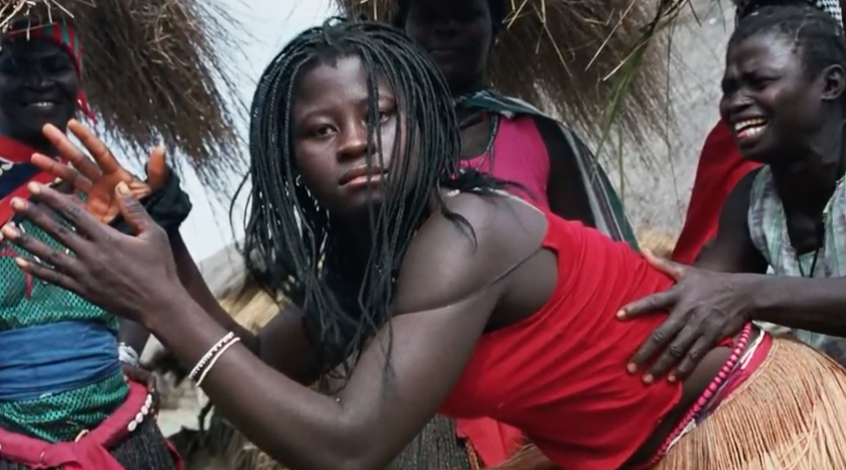
Marianne Lindberg De Geer
Jag blir mer och mer nyfiken på vad det var för ö och folkgrupp som Leyla Assaf Tengroth stötte på där i Bijagos. För ännu har jag inte funnit minsta lilla tecken på ngt annat än vanliga matriarkat i hela området och de lever fortfarande efter samma väl inrutade gamla livsmönster som alltid och är beskrivna in i minsta detalj i Heide Göttner Abendroth vetenskapligt framtagna definition av "matriarkat". I dem finns inget förtryck av männen och de knuffas aldrig ut att leva ensamma i utkanten av bygemenskapen utan de bor ju tillsammans med sin egen modersklan där de utgör sociala fäder till sina systrars barn. På fackspråk har det där tidigare kallats "avunkulat" och antagits fungera på samma sätt som patriarkat, fast med all makt hos morbröderna istället för fäderna.
Den som har läst Briffaults gigantiska kartläggning över jordens alla matrilineala folkgrupper i början av förra seklet vet ju dessutom att förbindelser utanför "äktenskapet" varit legio och det ifrån båda parters håll sas. Inte bara kvinnorna har därmed skaffat sig älskare vid sidan om utan det har skett på ömsesidig basis. De biologiska fäderna har hunnit gifta om sig många gånger om innan de hinner försvinna från detta livets goda och barnen stannar därvid alltid i mammans familj= matrilinearitet.
Matriarchies (Matriarcados). Anna Boyé. Resumen documental Bijagós. Guinea Bissau.
youtube.com
Marianne Lindberg De Geer / Tengroths "forskning": "Kvinnorna i byn sitter i möte när vi närmar oss bytorget. De ignorerar oss. De sitter i ring, det pågår något slags möte, de är klädda i kjol, brösten hänger nakna. Det finns inget kokett med dem, inga smycken, inga fantasifulla håruppsättningar som hos männen. Kvinnornas frisyrer är korta och naturliga. Flera av dem har pipa i munnen och en för oss typiskt manlig hållning. Genom det naturliga urvalet är männen mycket vackra, medan kvinnornas utseenden inte är det, med våra mått mätt.”
Ja ni ser ju själva den stora skillnaden!
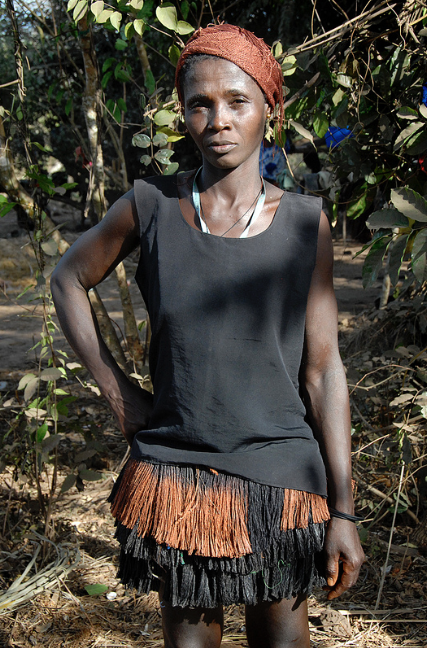
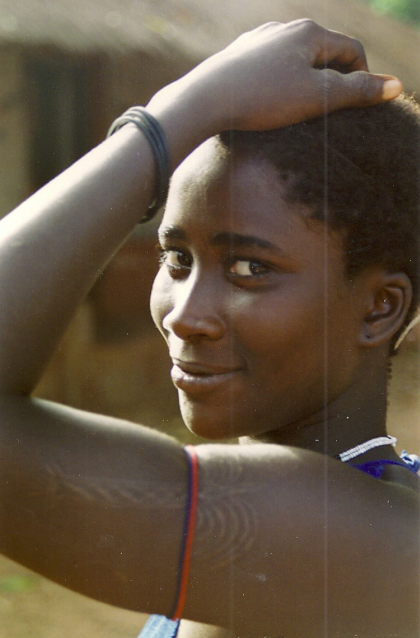
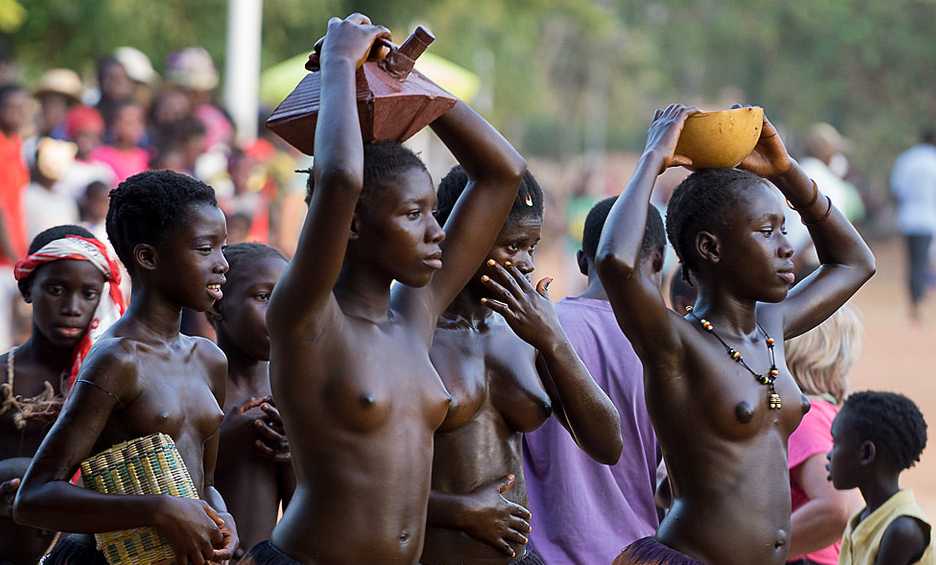
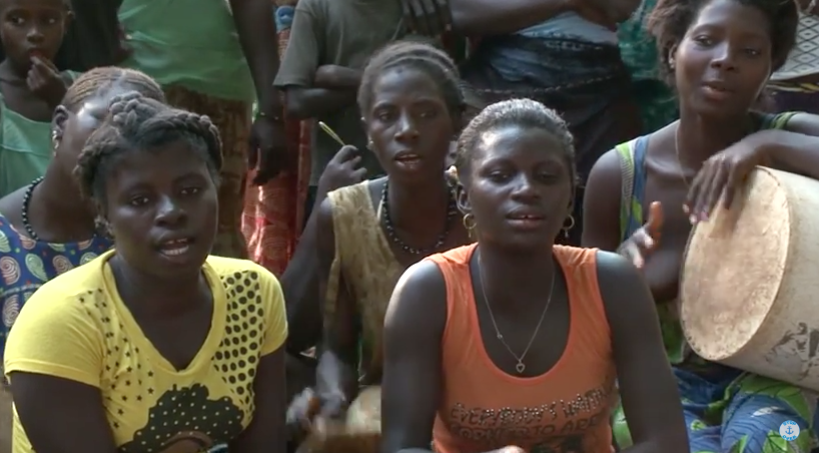
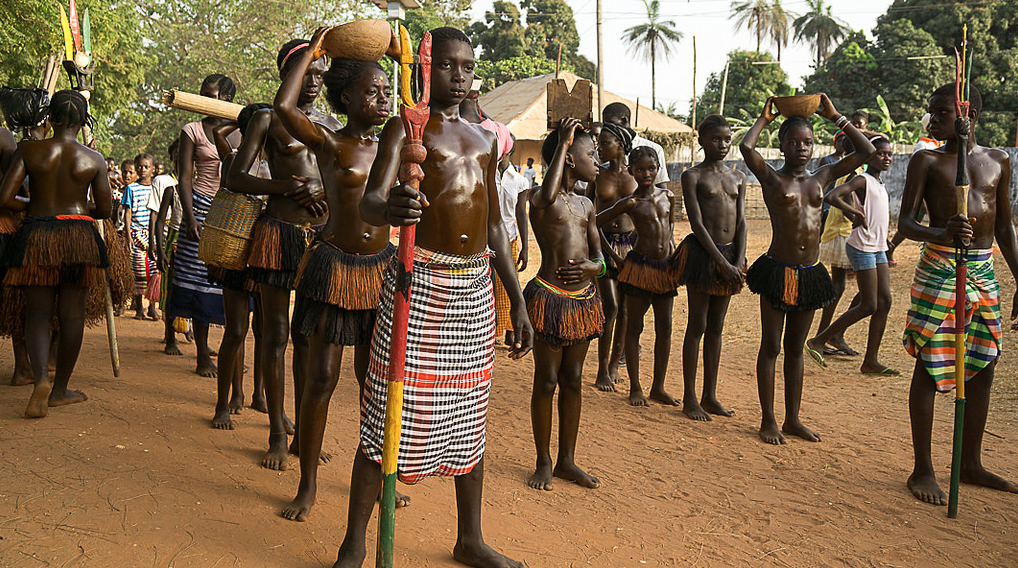
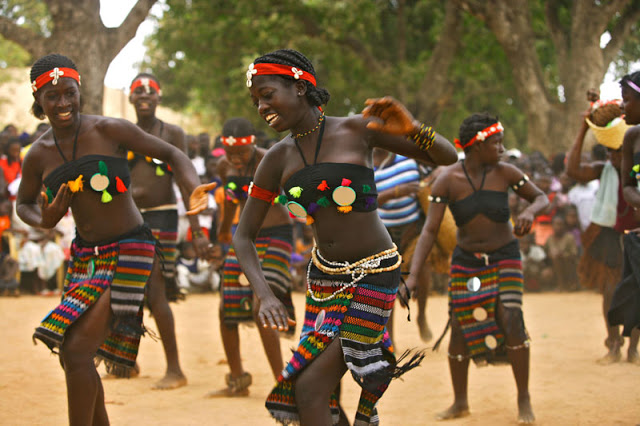
It was at a soccer tournament in the port town of Bubaque. The team from Etimbato Village was accompanied by a group of young women.
To cheer on their team, several of these women tapped handheld drums. The drums produced low tones - like a fisherman's plastic gasoline container bouncing around a rocky shoreline. The other women chanted in high happy voices. The chants were repetitive, and each chant ended with a long and soothing, musical note.
The upper thighs and healthy African buttocks of each woman were concealed by two rings made of hundreds of hanging sticks. The bottom ring had been dyed black. The upper ring was purple or brown or white, and black. I felt the tiny sticks of one woman's skirt; they seemed strong and sturdy, like tiny bamboo. These perfect skirts made their wearers much more special, in my eyes, than people wearing factory-made clothes.
Many of Etimbato's women also wore anklets. Eight or nine stones were tied loosely around their left ankles. When the women stomped, bare-foot, around the drummers, the stones clacked together to make a tambourine sound.
A few days later, I went at night to visit the school where the young men and women who'd come for the soccer tournament were staying. Every evening, there was a party.
Three girls stood playing simple rhythms on low-pitched drums. Sometimes, the rhythms became complex, brief jams. "A-tap tap a-tap-tap-tap."
Twenty girls moved in a circle around the drummers, in this night without electricity illuminated by the full moon. They slouched their shoulders and bent forward as they stepped. Sometimes, they stepped backwards, pushing their butts into the laps of the girls behind them. Other times, they turned their butts outward from the circle and faced inward and stomped around.
The way they kept circling in one direction, it gave me vertigo; it felt like they were performing black magic. They often kept a fire going in the center of the circle. It felt like they were the hostile natives celebrating my capture.
As they slouched and strutted around the circle, the girls wore smiles of confidence, as if this were the absolute correct thing they were born to do, proud of their heritage.
Orango Parque Hotel - Guinea Bissau - Bijagos EN
Web find sailiors and warriors from a proud past of the local population the Bijago. But those times lies far behind. Today these peaceful and hospital people maintain their strong cultural identity and live in complete harmony with nature. They have always known how to make the most of the naturel resources wothout dangering the lands where they have lived for so many generations. Part of their s lies in their deep ancestor believes which plants animals have souls. This is in grwat contrast to their simle life.
The Hotel love in perfect harmony of the local community
https://www.fokus.se/2016/11/var-gud-ar-en-kvinna/
R E F E R E N C I E S:
University Institute for Social Sciences, Business Studies and Technologies
Department of Anthropology
LIVING AT THE MARGINS.
YOUTH AND MODERNITY IN THE BIJAGÓ ISLANDS
(GUINEA-BISSAU)
by
Lorenzo Ibrahim Bordonaro
Thesis submitted in partial fulfilment of the requirements for the degree of
Doctor in Anthropology
(Anthropology of Culture and Symbolism)
Supervisor: Robert Lewis Rowland
September, 2006
Quote:
"According to Neil Smith, ‘the global restructuring of the 1980s and 1990s embodies not so much an evening out of social and economic development levels across the globe as a deepening and reorganization of existing patterns of uneven geographical development’ (1997: 183)
While major world institutions affecting national policies and pushing towards ‘globalisation’ of world economy (the BWIs, Bretton Wood Institutions), keep claiming that this process will bring economic growth and consequently development, democratisation and human rights, and social equity, a number of scholars (see for e.g. Silbey 1997, Mkandawire 2002. See also infra, Introduction) criticized the term ‘globalisation’ itself for it does not describe appropriately the kinds of interconnections between the local and transnational institutions, and does not communicate the idea of the hierarchy of transnational centres that control the flows of financial capital, cultural images and goods in what Michael
228
Hardt and Toni Negri has called ‘the Empire’ (2000). Gupta and Ferguson wrote in a remarkable passage:
The production and distribution of mass culture [...] is largely controlled by the notoriously placeless organizations, multinational corporations. The “public sphere” is therefore hardly public with respect to control over the representations that are circulated in it. Recent work in cultural studies has emphasized the dangers of reducing the reception of multinational cultural production to the passive act of consumption, leaving no room for the active creation by agents of disjunctures and dislocations between the flow of industrial commodities and cultural products. However, we worry at least as much about the opposite danger of celebrating the inventiveness of those “consumers” of the culture industry (especially on the periphery) who fashion something quite different out of products marketed to them, reinterpreting and remaking them, sometimes quite radically, and sometimes in a direction that promotes resistance rather than conformity. The danger here is the temptation to use scattered examples of the cultural flows dribbling from the “periphery” to the chief centers of the culture industry as a way of dismissing the “grand narrative” of capitalism (especially the “totalizing” narrative of late capitalism), and thus of evading the powerful political issues associated with Western global hegemony (1992: 19).
Ulf Hannerz admitted as well that ‘the overarching communication structures of the world today are, after all, center/periphery structures, heavily asymmetrical’ (1992: 29. See also 1996)
Anthropology, Luigi Scantamburlo
Sistemas sexo/género “matriarcales”: bijagó (guinea bissau) y zapoteca (méxico) Águeda Gómez Suárez Universidad de Vigo, España reSumen
Águeda GÓMEZ SUÁREZ Universidad de Vigo (España) agueda@uvigo.es
Luigi Scantamburlo, l. 1978 The Ethnography of the Bijagós People of the Island of Bubaque (Guine-Bis-sau), Masters of Arts, Michigan, Wayne State, Detroit.
Resistance is Fruitful: Bijagos of Guinea-Bissau Brandon D. Lundy
http://digitalcommons.kennesaw.edu/cgi/viewcontent.cgi?article=1000&context=working_papers_ccm
LIVING AT THE MARGINS.
YOUTH AND MODERNITY IN THE BIJAGÓ ISLANDS
GUINEA-BISSAU
Anthropologist Dr. Lorenzo Ibrahim Bordonaro, 2006
Sidan 15
I agree with Ahmed and Shore (1995) that the so-called postmodern current in anthropology and the transformation of the cultural landscapes of the contemporary world ‘provoked a chronic sense of insecurity and self-doubt about the legitimacy of the anthropological enterprise’ (Ahmed and Shore 1995: 14-15). According to these authors though, this is not a crisis of representation, but rather a problem of relevance, that compels anthropology to ‘[re-evaluate] its conventional objects of study and [to develop] new domains and methods of inquiry that are commensurate with the new subjects and social forces that are emerging in the contemporary world
SiddharthaFilms
Publicerades den 10 sep. 2015
September 10th, 1974, Guinea-Bissau, a small country in Western Africa, achieves its independence. Hundreds of European volunteers move to the country, chasing their dreams of a better world. Those were years of enthusiasm and idealism, when the building of a socially just nation in Africa was a dream within reach.
Time passed and those dreams were hit by the reality of political instability and turmoil. Most of the volunteers returned home, but the bittersweet memories of their lost paradise remain as vivid as the day they left.
The Vanished Dream is a story about a time when changing Africa and the world seemed possible.
BIRGITTA DAHL
Birgitta Dahl was a member of the Swedish Parliament from 1969 to 2002. During that time she was also Minister of Energy Affairs, of Environment, and Speaker of the Parliament.
As a close confidant to the Prime Minister of Sweden
LARS RUDEBECK
Lars Rudebeck is a Professor Emeritus of Political Science at the Uppsala University in Sweden. He visited together with Birgitta Dahl Guinea-Bissau’s liberated areas during the Liberation War.
He has travelled many times to Guinea-Bissau, becoming one of the most renowned experts on the country in the field of political science.
JOOP DE JONG
Joop de Jong arrived as a young doctor in Guinea-Bissau during the Liberation War. After the independence, in 1980, he was charged with setting up the National System of Mental Health.
He left Guinea-Bissau in 1985 and founded the NGO Transcultural Psychosocial Organization (TPO). He specialised in psychiatry and works as an advisor for the World Health Organisation and United Nations..
NIKOLA ARSENIC
Nikola Arsenic is a Serbian architect. He met the PAIGC leader Alberto Lima Gomes in Belgrade Architecture University in the 70’s. Lima Gomes became Minister of Public Works and asked his friend Nikola to join him and help to build the new State. Nikola went to Guinea-Bissau with his wife and two children as the first international aid worker of the country. He planned and designed the most prominent buildings that were constructed after the independence. He left Guinea-Bissau in 1981.
Sistemas sexo/género “matriarcales”: bijagó (guinea bissau) y zapoteca (méxico) Águeda Gómez Suárez Universidad de Vigo, España resumen
Águeda GÓMEZ SUÁREZ Universidad de Vigo (España) agueda@uvigo.es
Luigi Scantamburlo, l. 1978 The Ethnography of the Bijagós People of the Island of Bubaque (Guine-Bis-sau), Masters of Arts, Michigan, Wayne State, Detroit.
Resistance is Fruitful: Bijagos of Guinea-Bissau Brandon D. Lundy
http://digitalcommons.kennesaw.edu/cgi/viewcontent.cgi?article=1000&context=working_papers_ccm
Number 1 - Resistance is Fruitful: Bijagos of Guinea-Bissau
Brandon D. Lundy
Kennesaw State University, blundy@kennesaw.edu
http://digitalcommons.kennesaw.edu/cgi/viewcontent.cgi?article=1000&context=working_papers_ccm
Tired of Weeping: Mother Love, Child Death, and Poverty in Guinea-Bissau (Women in Africa and the Diaspora)
Jonina Einarsdottir
In this comprehensive and provocative study of maternal reactions to child death in Guinea-Bissau, West Africa, anthropologist Jonina Einarsdottir challenges the assumption that mothers in high-poverty societies will neglect their children and fail to mourn their deaths as a survival strategy. Based on ethnographic fieldwork conducted from 1993 to 1998 among the matrilineal Papel who reside in the Biombo region, this work includes theoretical discussion of reproductive practices, conceptions of children, childcare customs, interpretations of diseases and death, and infanticide. Einarsdottir also brings compelling narratives of life experiences and reflections of Papel women.